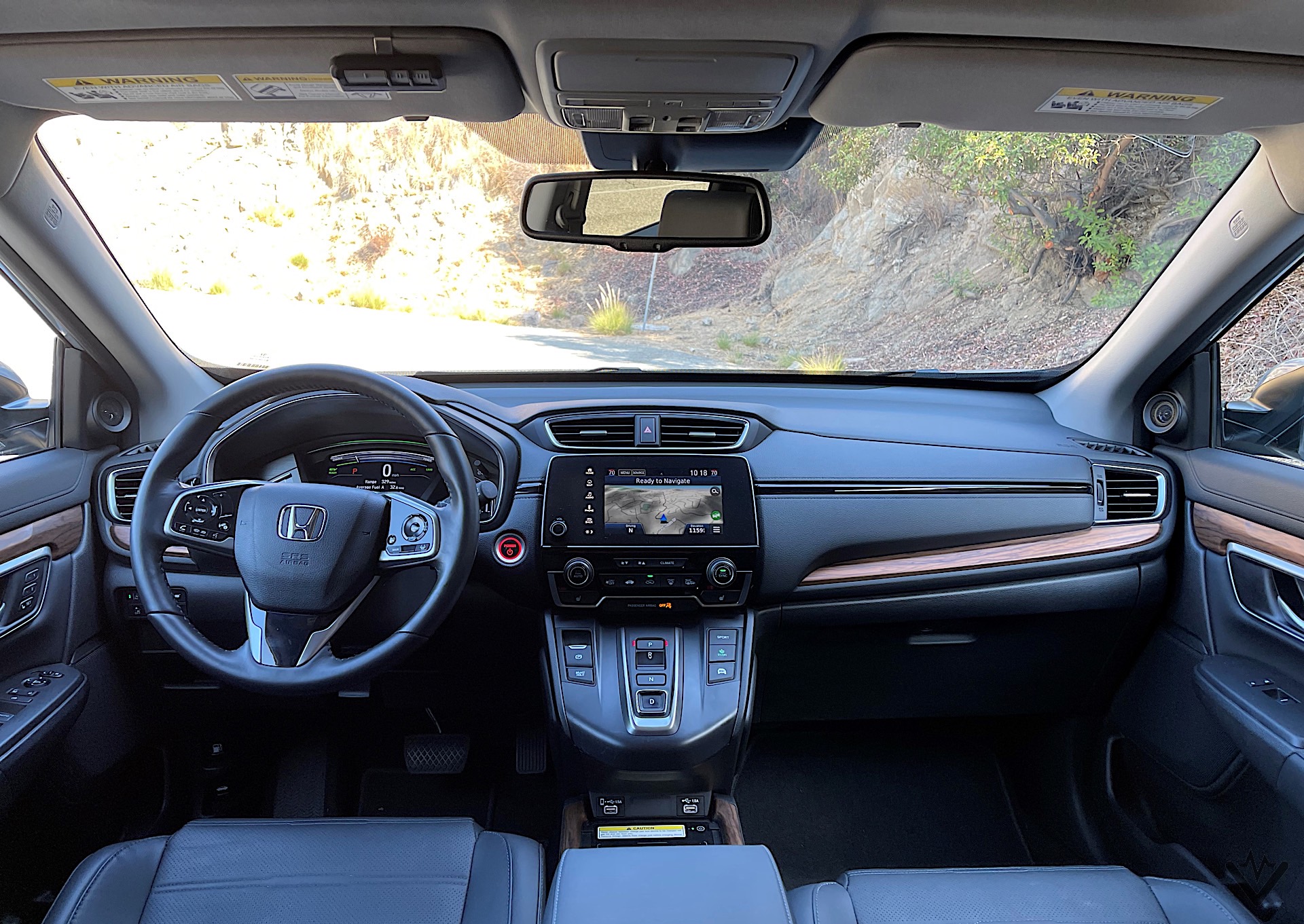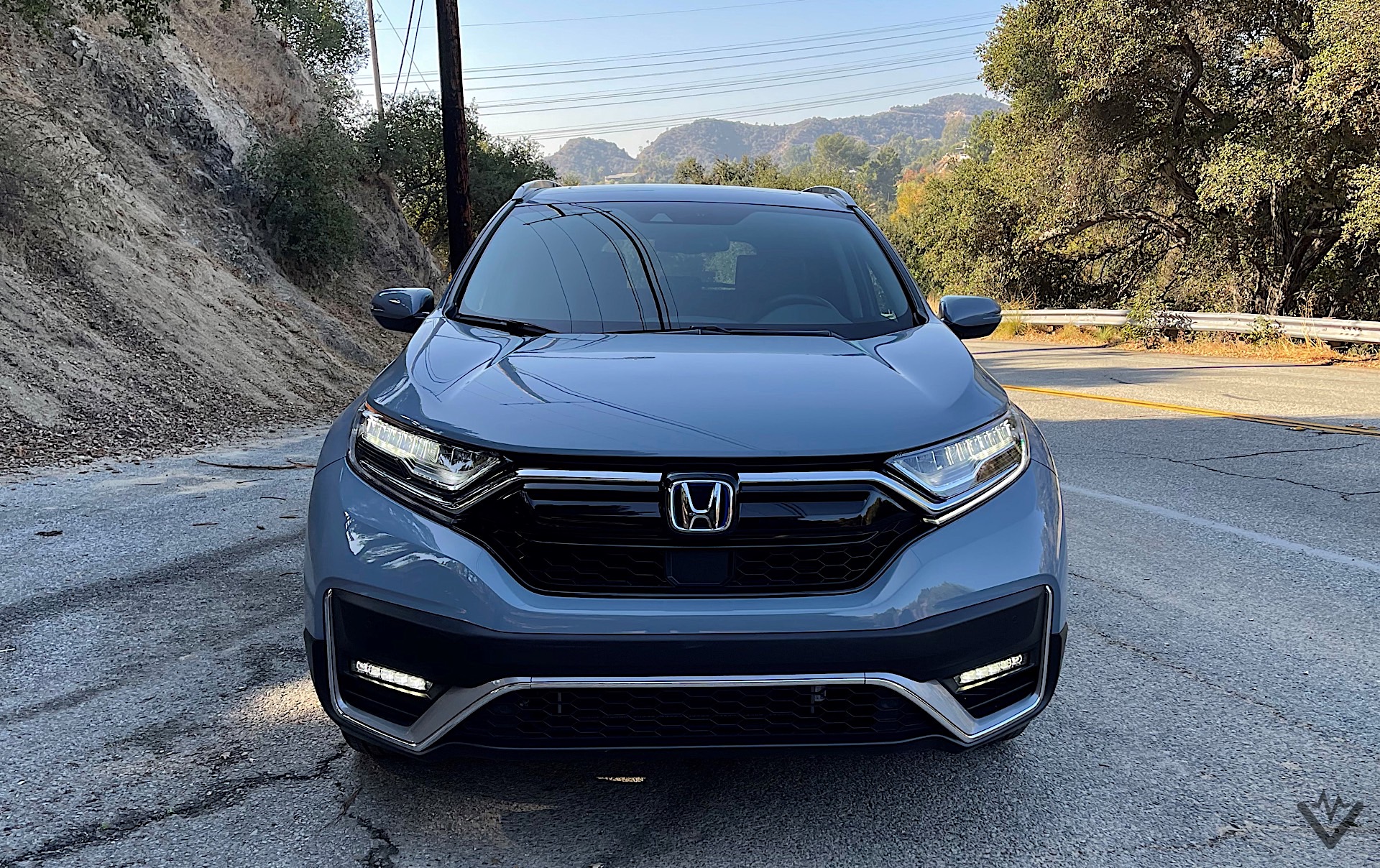2020 Honda CR-V Hybrid review: The class benchmark electrified
2020 Honda CR-V Hybrid – Photo credit: Stefan Ogbac / EV Pulse
Every compact SUV that enters the market gets compared to the Honda CR-V for a reason. No other competitor blends comfort, agility, efficiency, and space so wonderfully. In short, the CR-V does nearly everything well. Now we have the 2020 Honda CR-V Hybrid, which promises to build on the standard model’s goodness with an efficient yet powerful electrified powertrain. Let’s see if this electrified SUV hits the mark as well as the standard model.
2020 Honda CR-V Hybrid exterior

Other than mild design tweaks that came as part of the refresh for the 2020 model year, the Honda CR-V Hybrid retains an evolutionary exterior. It’s still upright, has a short nose, a nearly vertical rear hatch, and an angled A-pillar that’s distinguished the SUV for the last three generations. Blue Honda badges, hybrid badges on the front fenders and tailgate, and standard LED headlights are the only cues distinguishing the CR-V Hybrid from the standard model.
2020 Honda CR-V Hybrid interior

The first thing you’ll notice about the Honda CR-V Hybrid is the thoughtful cabin layout. There are many places to store your small items and mobile devices, and the center console storage area is reconfigurable. Everything you touch feels high quality and the harder, cheaper bits are smartly placed away from areas you touch. Big windows provide excellent visibility while two levers in the cargo area let you fold the 60/40 split-folding rear seats with ease. Even with the lithium-ion battery taking up some of the cargo space, there’s still plenty of room for your stuff. Five adults sit comfortably, too thanks to excellent head and legroom. On the highway, the passenger compartment stays well-insulated with just a smidge of wind buffeting and road noise.
If there was one thing the CR-V’s interior could use, it’s a better infotainment system. Although the controls are simple, the 7.0-inch touchscreen is small by today’s and its response times are too slow. Grainy graphics further hint at this interface’s age, holding it back against newer, more modern multimedia systems found in competing Hyundai, Kia, FCA, and General Motors vehicles. Honda’s own upgraded nine-speaker audio system could be clearer, and isn’t as crisp as the 10- and 12-speaker units found in the Accord, Civic, and Insight. Competitors’ Harman Kardon, Bose, and JBL units also offer better listening experiences.
2020 Honda CR-V driving impressions

Get the CR-V Hybrid on the road and you’ll immediately realize this is textbook Honda engineering excellence. The chassis stands out with its blend of suppleness and sharpness. Road imperfections are dispatched promptly and passengers barely feel impacts even with the Touring trim’s 19-inch alloy wheels shod in 235/55R19 tires. Get yourself on a twisty road and the CR-V gleefully turns in. Excellent body control coupled with agile handling gives this SUV the surefootedness of a smaller vehicle. Together with the quick, accurate steering and the low center of gravity, the CR-V Hybrid inspires driver confidence.
Further helping the CR-V Hybrid drive well is the powertrain. It couples a 2.0-liter I-4 to a lithium-ion battery and two electric motors. With a combined output is 212 hp and 232 lb-ft of torque, the car can merge, pass other traffic, and climb steep inclines easily. Due to the system’s configuration, the CR-V Hybrid feels like an EV with a backup plan because it barely uses the gas engine for assistance. The only time you know there’s a gas engine under the hood helping out is during hard acceleration because the mill gets thrashy.
Honda’s hybrid vehicles have some of the best braking feel. Transitions between regenerative and mechanical braking in the CR-V Hybrid are so imperceptible they feel normal. Best of all, the firm brake pedal gives you a good sense of how much stopping power you’re inputting, allowing for consistently smooth operation. Four levels of regenerative braking toggled via the paddle shifters give you another layer of control and will even charge the battery while coasting or slowing down.
On the driver assistance front, the Honda Sensing suite works unobtrusively. There’s no raucous warning noise that other systems make, just little chimes and friendly reminders. Honda’s adaptive cruise control is calibrated nicely, leaving roughly a car length between you and the vehicle ahead in its closest setting. Lane centering could be a little more assertive when taking easy turns though; it tends to get too close to the dividing lines on the highway.
2020 Honda CR-V Hybrid pricing
With the destination, our 2020 Honda CR-V Hybrid Touring test vehicle cost $37,070 including the $1,120 destination charge. That’s less than a loaded Toyota RAV4 Hybrid or Ford Escape Hybrid, both of which can easily top $40,000 if you’re not careful with the options.
Final verdict

Nearly five years into its current generation, the Honda CR-V remains at the top of the compact SUV class. Not many can match its balance and multi-talented nature, especially in hybrid guise. The fact that the hybrid makes up 10 percent of CR-V sales speaks to its excellence, and there’s no doubt that number will continue to grow as Honda continues to electrify its lineup. Sure, the CR-V Hybrid has a few weak points but they don’t outweigh the strengths. The fact that you get more power, standard AWD, and an EPA fuel economy rating of 40/35 mpg city/highway makes the CR-V Hybrid a strong proposition even with the slightly higher price tag. If you’re looking for a compact SUV with next to no compromise, you’ve found it.
At a glance
- Year: 2020
- Make: Honda
- Model: CR-V Hybrid
- Trim: Touring
- Type: 4-door compact crossover
- Combined horsepower: 212
- MPG ratings (city/highway/combined): 40/35/38
- Pros: Great ride and handling, well-packaged interior
- Cons: Engine gets noisy at higher speeds, dated infotainment system
- Base: $31,710
- Price as tested: $37,070

